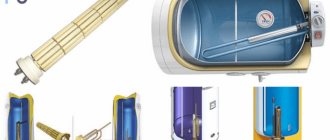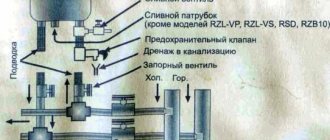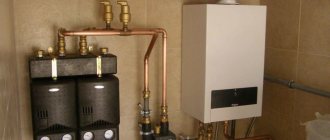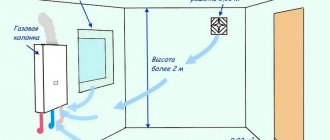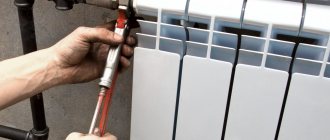Inside any storage water heater there is a metal rod - an anode made of a magnesium-aluminum alloy. The element serves as protection for the tank and is gradually corroded during operation. It is important not to miss the moment of final destruction - to promptly replace the magnesium anode, and at the same time clean the container and tubular electric heater (abbreviated as heating element) from scale. We do not invite plumbers; we carry out the work ourselves and completely free of charge.
Operating principle of the anode
When water is heated, oxygen dissolved in it begins to be actively released. Oxygen is a powerful oxidizing agent, so it actively interacts with the metal body and parts of the water heater, oxidizing them. This causes corrosion of the housing and premature failure of the water heating element.
Magnesium is more reactive than ferric iron. Therefore, it enters into an oxidation reaction with free oxygen more actively than iron, thus protecting the walls of the tank body and water heating element from the formation of rust.
The water supplied through the water supply system contains Ca and Mg bicarbonates. They are soluble in water, therefore they dissociate into Ca 2+, Mg2+ cations and HCO3– anions.
Magnesium, which coats the steel anode rod, interacts with water and increases the number of cations that bind HCO3- anions.
As a result of the reaction, a large amount of slightly soluble salt MgCO3 is formed and the formation of insoluble calcium carbonate salt CaCo3 is significantly reduced. The resulting scale has a loose structure and is easily removed from the water heating element during its operation and settles to the bottom of the boiler.
Cumulative or flow-through
In fact, the choice is not that great. There are two main types of water heaters:
instantaneous water heater
storage boiler
In a flow type, the water heats up very quickly; it only needs to pass through the heating element. It seems that what else is needed?
However, such heating implies a sharp decrease in the maximum possible pressure.
If you want to get a more powerful flow, in this case you will have to use a more powerful heating element from 8 kW to 30 kW!
In storage water heaters, there is practically no change in pressure. What's in is what's out.
Thanks to this, this type can simultaneously provide several points in the house with hot water supply. But this is when using a water heater of the appropriate volume (100-150-200l).
And their choice of volume is quite extensive - from 5 to 300 liters.
Purpose and functions of a magnesium rod in a boiler
Coating a steel rod with a layer of magnesium does not affect the cost of the water heater; it is the most accessible and cheapest material. It is installed in close proximity to the water heating element.
Magnesium has a greater potential difference than copper or aluminum heating elements. Due to this, particles of the formed salts settle on its surface, leaving the heating coil clean and untouched. The salts settle unevenly in a loose, porous layer, which can be easily cleaned off with a sharp object.
This allows you to increase the service life of an expensive water heating element.
- During operation of the boiler, microcracks and scratches form on its body, and paint chips occur as a result of mechanical stress.
- Free magnesium cations actively interact with oxygen dissolved in water.
- Thus, corrosion occurs on the magnesium rod, protecting the metal body and internal parts from damage.
The sacrificial anode reduces water hardness and reduces the amount of salts entering the hot water supply system. This reduces their deposits on pipes and inside taps and increases their service life.
SCALE
Scale is solid deposits of salts that enter the water supply system in dissolved form from groundwater and artesian wells.
Scale forms when water is heated: the higher the water temperature, the more scale there is. Most scale accumulates on surfaces exposed to direct heating: in a water heater this is an electric heating element.
| Want to know if there is limescale in your water heater? Turn it off for one hour. Water will seep into microcracks in the scale layer. Once turned on, the water will remain “trapped” between the wall of the container and a layer of scale and will begin to expand when heated. You will hear a "crackling" sound coming from the heater. |
Why is scale harmful?
1. Scale accumulates in pipes and narrows passages, especially in bends, forming blockages and reducing water pressure in the system.
2. Scale acts as a heat-insulating material. A layer of scale on the heating element reduces its heat transfer and increases energy consumption: heating water will be more expensive.
3. Under the layer of scale, corrosion processes gradually develop, leading to equipment breakdown.
When is it necessary to replace the magnesium anode in a boiler?
Like any protective element that takes a hit when an electrical appliance is operating, the anode needs to be replaced in a timely manner. The more often the water heater is used, the faster the sacrificial element wears out. It is advisable to replace it once a year.
Characteristic signs of the need to replace the protective element:
- The water heater takes longer to heat the volume of water, and its operating time increases noticeably.
- When heating, it turns off before the water heats up to the set temperature, and then turns on again after a few minutes. This leads to increased energy consumption.
- The hot stream acquired a cloudy hue with a sharp, unpleasant odor of hydrogen sulfide.
- The main sign of failure of the protective element is the appearance of unusual, loud sounds. They occur only when the heating element is operating. At the first stage, noise appears, turning into sharp pops that shake the boiler body.
If characteristic signs of malfunction of the boiler appear, it is necessary to repair it, clean it and replace the worn element. A simple procedure allows you to increase the service life of your water heater to 10-12 years and avoid purchasing a new electrical appliance.
Some tips
Anode - a metal pin with a 10-15mm layer of magnesium alloy applied to it
- Buying a boiler does not mean acquiring carelessness when heating water. Check it even by ear - if there is a hissing sound when heating, it means that the heating element is coated with plaque.
- Salt deposits are a common phenomenon, even when the water seems clean and clear to us. Salts are always present in water, the only question is their concentration. If there are a lot of salts, then the anode, with all its positive properties, is not able to cope with them.
- Determining how often you need to look inside the boiler and observe the condition of the anode can only be done experimentally. That is, after the Nth amount of time the water heater has been operating, do not be lazy to look inside. If the magnesium anode is destroyed by at least half, then “measure” it the same amount of operating time. If desired, you can replace it then to be sure of the protection of the water heater.
- Try to never allow the boiler to operate without a magnesium anode. You can always buy it and, believe me, much cheaper than the boiler itself.
- Replacing the magnesium anode is easy and does not require any special tools. In this case, the main thing will be compliance with safety measures. Remember that you can buy a magnesium anode, but life cannot.
- Typically, all manufacturers without exception try to warn consumers about cleaning boilers every 12 months of active use. Practice shows that such actions can be performed even more often. This may seem burdensome at first glance, but in reality it is very useful. By removing deposits at the bottom of the boiler or from the heating element, checking the wear of the magnesium anode - with all this you extend the life of the water heater.
Prometheus for a boiler - this is how a magnesium anode can be poetically called. It gives us clean water and protects the water heater itself, although it invariably gets destroyed. Sometimes such self-sacrifice can occur in technology, and not just in people.
Types of magnesium anodes
The magnesium anode is made in the form of a metal rod onto which a layer of magnesium up to 2 mm thick is sprayed. Its length varies from 10 cm to one meter and depends on the size of the boiler. In domestic water heaters with a volume of up to 80 liters, it is installed next to the heating element on a small round platform using a threaded connection.
In electrical appliances that are used in hotels, hostels, production workshops and have a volume of more than two hundred liters, it is installed on top of an element that is screwed into the body.
Depending on the number of rods, single and multi-section protective devices are produced.
- The base of the rod is made of high-carbon steel or in the form of a plastic fine mesh.
- The plastic rod has small holes into which magnesium cations freely penetrate and are distributed in the aquatic environment.
- Magnesium powder is poured inside the empty cavity of a plastic tube.
- It is easy to add it inside as it is used up, plastic is a flexible material and replacement is faster and easier.
Price
Currently, magnesium anodes are produced and sold, which differ in the length of not only the anode itself, but also the internal pin. The standard length of the purchased anode for water heating equipment can vary in a fairly wide range - 10-60 cm with a pin length of 1.0-23 cm.
Among other things, the anodes differ in terms of overall diameter - 1.4-2.2 cm, and in the diameter of the threaded connection of the stud - “M-4”, “M-5”, “M-6” and “M-8” .
The average cost of the most common models of protective magnesium anodes for household storage boilers:
- 100 mm with D14+20 mm and “M-4” - 200-220 rubles;
- 100 mm with D18+180 mm and “M-6” - 230-250 rubles;
- 100 mm with D18+230 mm and “M-6” - 250-270 rubles;
- 110 mm with D21.3+10 mm and “M-5” - 320-330 rubles;
- 120 mm with D16+10 mm and “M-6” - 150-160 rubles;
- 140 mm with D14+20 mm and “M-4” - 130-140 rubles;
- 145 mm with D25+10 mm and “M-5” - 290-310 rubles;
- 200 mm with D16+35 mm and “M-6” - 280-290 rubles;
- 200 mm with D18+180 mm and “M-6” - 290-310 rubles;
- 200 mm with D16+10 mm and “M-4” - 290-310 rubles;
- 210 mm with D22+10 mm and “M-6” - 360-380 rubles;
- 210 mm with D18+10 mm and “M-4” - 310-320 rubles;
- 230 mm with D22+10 mm and “M-5” - 380-400 rubles;
- 300 mm with D21+10 mm and “M-8” - 440-460 rubles;
- 660 mm with D21.3+13 mm and “M-8” - 810-830 rubles.
Safe operation of the device during pressure drops when heating water is ensured by a safety valve for the water heater. Read in detail about the purpose and installation of the device.
Don’t know which electric heated towel rail is best to choose for your bathroom? Read this article.
Such a noticeable variation in size and cost is not accidental, and makes it quite easy to independently select the most optimal magnesium anode option for water heating devices that differ in length, shape and structural characteristics.
Replacing the magnesium anode (step-by-step instructions)
Prevention is done once a year after characteristic signs of wear of the protective rod appear. All work is carried out with the power supply turned off.
The service instructions for the electrical appliance indicate the location of the magnesium rod. Manufacturers develop and use various modifications. This is worth paying attention to when purchasing it.
If the anode is installed at the bottom next to the heating element, the boiler does not need to be removed from its mounts. If it is at the top and the ceiling height does not allow for repairs and removal of the anode from the housing, the electric heater is removed from the wall or platform.
- The water is first drained from it. To do this, there is a check valve at the bottom of the product body, but to avoid splashing water, it is advisable to use a hose.
- At the bottom of the water heater there is a protective casing that must be removed. Inside there is a flange and a heating sensor, which are also dismantled.
- With a light movement, to avoid damage to the housing, unscrew the heating element. Next to it is an anode, which must be unscrewed and replaced with a new one. The heating element must be cleaned of salt deposits and thoroughly rinsed with running water. Clean it with a sharp knife, sandpaper, screwdriver or metal spatula.
After replacing the rod, the heating element is installed back, tightened and the boiler is placed in its designated place.
After the repair is carried out, it is worth recording the date of its replacement. The magnesium anode is replaced every year.
We service the indirect heating tank
Let us note right away that the replacement operation here is much simpler than in electric boilers. Since the anode in an indirect water heater is located at the top and is in no way connected with other elements - a heat exchanger or an additional heating element in combined models.
Combination heating apparatus design
How to change the anode in a floor-mounted indirect heater:
- Turn off the cold water supply.
- There is no need to empty the tank, you just need to relieve the pressure. Open the “hot” valve on the mixer and drain 2-3 liters of water through the drain valve of the device, then cut off the DHW line.
- Using an open-end or spanner wrench, unscrew the plug on the lid of the container and pull it out along with the old anode.
- Unscrew the rod with pliers, screw a new one in its place and tighten it by hand.
- Insert the element into the tank and tighten the plug with a slight force so as not to squeeze the rubber sealing ring. It is advisable to check the latter after disassembly and, if necessary, replace it.
Advice. Before disassembling, it is worth turning off the boiler circulation pump so that the coolant does not circulate through the coil.
The rod is changed in a similar way on stationary water heaters equipped with a gas burner. The work order is shown in the video:
If it is necessary to service the wall-mounted version of the “indirect”, the water will have to be drained. The protective rod is removed using the technology described in the previous section about electric models.
Photo of magnesium anode for water heaters
What will be needed for repairs?
If the presence of a malfunction is still confirmed, then it’s time to start replacing the heating element. But before you get started, you need to acquire all the necessary tools. The list is small, but without it it’s unlikely that anything will be done.
For repair you will need:
- spanners;
- pliers;
- rags or napkins - they should absorb water well;
- screwdrivers - it is advisable to stock up on Phillips and straight screws;
- phase meter - the tool is a screwdriver with a special indicator built into the handle;
- new heating element.
Armed with everything you need, you can proceed directly to the repair. For everything to be successful, you need to follow a certain order of actions, which will be discussed below.
Although the vast majority of boilers differ from each other in appearance and characteristics, as a rule, they have an identical design

